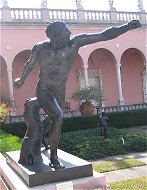Borghese WarriorMuseum Label: Chiurazzi description: |
Subject info:
This sculpture was first recorded in 1611 when it was being restored after having
just been found near Anzio. It was then taken to Cardinal Borghese's estate. In 1807 it
was bought by Napoleon Bonaparte, brother-in-law of prince Camillo Borghese, and shipped
to Paris.
Seventeenth-century observers seem to have had no doubt that the subject was a gladiator, and that the original would have held a sword or shield and some casts were produced this way. In the mid 18th century scholars thought that it could not have been a gladiator, since Greeks would never have erected a sculpture to a gladiator and that gladiators did not exist at the time when this was made. It was thought to be Ajax( or his father Telamon), outside the walls of Troy, as was sometimes shown on the coins of Locri. Others thought it to be a dancer. However, when the sculpture was installed in its own room in 1830, the name of the room was "Salle du Heros Combattant, dit le Gladiateur", and that name stuck.
Another entry:
The Borghese Gladiator - originally part of the Italian collection whose name it bears -
is actually a depiction of a fighting warrior. The piece, whose tree trunk bears the
signature of Agasias of Ephesus, son of Dositheus, recalls the work of Lysippos, the great
bronze sculptor of the fourth century BC. The accented musculature, however, bears the
mark of the Pergamene school. Agasias revived the athletic heroism of Lysippos, blending
it with the pathos of the Hellenistic period.
Since its discovery in the early seventeenth century, the Borghese Gladiator has been
praised as an aesthetic model of the male nude in motion. It was endlessly copied, modeled
and adapted by both modern and contemporary artists. For a long time, it was erroneously
thought that the figure was a gladiator (despite the fact that the Greeks did not hold
gladiatorial circus entertainments), before the shield strap on its left arm identified
him as a warrior. Our hero defends himself energetically, thrusting his torso forward in a
movement that is both defensive and self-protective. Protected behind his shield, he
prepares to riposte, his face turned sharply towards his opponent (perhaps a horseman?).
The piece, signed on the tree trunk by Agasias of Ephesus, son of Dositheus, has been the
subject of controversy as to its place in Greek art. It was created circa 100 BC.
Nevertheless, the figure's elongated silhouette, the reduced proportions of the head and
the vigorously-modeled muscles are reminiscent of the work of Lysippos of Sicyon, the
great bronze sculptor of the fourth century BC. The Borghese Gladiator could thus be a
Hellenistic copy - fashioned for a Roman client - of a bronze made by Lysippos or one of
his followers in the late classical period. The presence of the tree seems to confirm this
hypothesis - it probably shows the need to strengthen a work that was originally in
bronze, thus requiring no support - that was then transposed into marble, a much heavier
material, and more easily broken.
More than a straightforward, faithful reproduction of a Greek original, this statue should
be seen as Agasias's liberal interpretation of the classical model, to which he has added
innovations from his own era. The statue clearly falls within the scope of the aesthetic
experiments of the late Hellenistic period, particularly the influence of the baroque
scultpural creations of Pergamon. The boldness of the composition, which anchors the
warrior in a three-dimensional space and invites the spectator to view it from all sides,
is a constant in Hellenistic art. The exaggerated rendering of the musculature and the
violence of the figure's movement - organized along a broad diagonal - recalls the friezes
of the Pergamon Altar, erected in the early second century BC, which depicts the battle
between the Gods and the Giants. The pathos in the treatment of the face accentuates the
intensity of the warrior's efforts.
https://shl.stanford.edu:3455/9/750
